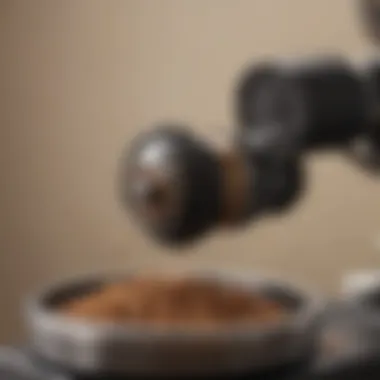Mastering Burr Grinding: Techniques for Flavorful Results


Intro
Burr grinding represents a fundamental process, especially in the realms of coffee and spice preparation. This technique is more than just a way to reduce items into smaller pieces; it fundamentally influences the flavor profile and consistency of what is produced. The method utilizes two burrs—a stationary and a rotating one—to efficiently achieve the desired grind size.
The purpose of this article is to dissect the burr grinding process and provide culinary enthusiasts with valuable insights. Understanding the types of grinders, their mechanical design, and the implications of various grind sizes offers an advantageous edge in preparation. Whether you're focused on enhancing the flavor of your morning coffee or seeking to maximize the essence of spices in your meal, comprehending burr grinding is essential.
By the end of this exploration, readers will gain practical tips to select the right burr grinder tailored to individual culinary needs, ultimately enhancing their overall cooking experience. Below are the main hinges of what this article will elucidate.
- The mechanics behind different types of burr grinders.
- How grind size can affect extraction during coffee brewing or spice blending.
- Guidance on selecting a burr grinder that suits various culinary applications.
- Efficient grinding techniques to support a fast-paced lifestyle without losing quality.
Let's delve deeper into the heart of burr grinding and appreciate its critical role in our culinary practices.
Prelims to Burr Grinding
Burr grinding is an essential process within the realms of coffee and spice milling. This technique plays a critical role in determining the flavor profile and consistency of grinds, which directly impacts the overall culinary experience. For culinary enthusiasts looking to elevate their cooking or brewing skills, understanding the nuances of burr grinding becomes paramount. It provides a means to attain precision in flavors, ensuring each cup of coffee or dish seasoned with spices achieves its fullest potential.
Definition of Burr Grinding
Burr grinding refers to the method of grinding where the material is crushed between two serrated surfaces known as burrs. Unlike blade grinders, which chop ingredients unpredictably, burr grinders offer a consistent and uniform particle size. This uniformity is vital for the extraction process, especially in coffee brewing. The specific grind size, which one can adjust, can contribute significantly to the taste, aroma, and overall quality of the brewed beverage or the dish being prepared. Burr grinders can be categorized mainly into two types: flat burr grinders and conical burr grinders, each with its own unique characteristics influencing the grind process.
History of Burr Grinding
The origins of burr grinding can be traced back to antiquity. Evidence suggests that ancient civilizations used primitive grinding tools resembling today’s burr grinders. These early devices involved hand-cranked mills with two opposed surfaces that ground grains, spices, and even medicinal herbs. Over centuries, the technology evolved. By the Industrial Revolution, the mechanization of grinding tools transformed the burr grinding method. High-quality steel burrs began to replace stone ones, enhancing durability and efficiency. Today’s modern burr grinders, equipped with electrical power and finely-tuned adjustments, are a testament to the century-old craftsmanship combined with cutting-edge technology. Understanding this history reveals how culinary practices have evolved and how burr grinding became a notable component in achieving superior flavor in food and beverages.
Types of Burr Grinders
Burr grinders are essential tools that significantly impact every cup of coffee or dish made using spices. Understanding the various types of burr grinders empowers culinary enthusiasts to make informed choices that meet their specific grinding needs. These grinders operate by churning ingredients between two surfaces, thus allowing for a more consistent grind, which is crucial for taste and texture.
Flat Burr Grinders
Flat burr grinders consist of two parallel flat plates that rotate in opposite directions. The distance between these plates can be adjusted, allowing users to have a fine control over the grind size. This type offers a high degree of consistency, making them a favored option among professional baristas and serious home brewers.
Key Features:
- Uniform grind size: Essential for optimizing extraction during coffee brewing.
- Easy adjustment: Users can tailor their grind preference depending on brewing method.
- Maintains flavor: It heats less compared to blades, resulting in less flavor loss.
However, one disadvantage of flat burr grinders is their relatively higher maintenance requirement compared to their conical counterparts. They accumulate a substantial amount of coffee ground residue, which can impact flavor if not regularly cleaned. Additionally, the wear of the flat burrs might occur more quickly than conical burrs which can necessitate more frequent replacements.
Conical Burr Grinders
Conical burr grinders feature a cone-shaped burr that fits inside another conical burr. This design allows for a method of grinding that is generally quieter and produces less heat. The versatility of the grind settings ranges from fine to coarse, making them suitable for various brewing methods.
Advantages:
- Less heat generation: Preserving the intricate flavors in the beans is crucial for premium coffee quality.
- Gravity-assisted: The beans naturally move through the grinder, which enhances efficiency and results.
- Durability: Typically, these burrs last longer and are easier to clean when compared to flat models.
Nonetheless, conical burr grinders can be expensive, and the size and weight of some models might be cumbersome for household use. The seemingly slight difference between these burrs' construction can greatly influence the grinding process, leading to variety in flavor profiles, thus full evaluation helps in selecting the right grinder.
Electric vs.
Manual Burr Grinders
The choice between electric and manual burr grinders depends significantly on personal preferences, lifestyle, and budget. Understanding the advantages may help users to make a careful decision that aligns with their brewing habits.


Electric Burr Grinders:
- Convenience: Quick grind times can be beneficial for those rushed in the morning.
- Powerful: Efficient for a larger quantity of beans, advantageous for brewing multiple cups.
- Consistent results: Provides precision without requiring extensive effort.
Nonetheless, they require access to power and come at a higher initial cost.
Manual Burr Grinders:
- Portability: These grinders are more easily transported, suitable for travelers or outdoor enthusiasts.
- Quiet operation: Ideal for those who may not want the noise associated with electric starting their day.
- Cost-effective: Generally less expensive than their electric counterparts.
Regard the considerations of supposed users; a serious brewing enthusiast may inevitably gravitate toward electric models while a casual drinker might enjoy a manual option. Evaluating preferred brewing times and settings can prove a useful guiding principle in choice.
Important Note: When selecting a burr grinder, prioritize characteristics that focus on achieving the desired grind size and flavor extraction relevant to your brewing method.
Mechanics of Burr Grinding
Understanding the mechanics of burr grinding is vital in appreciating how this technique affects the overall flavor and texture of ground coffee and spices. This section explains the fundamental operations within burr grinders, detailing how they transform whole beans or spices into a consistent powder suitable for various culinary applications. Accurate grinding not only impacts flavor extraction but also enhances culinary practices.
How Burr Grinders Work
Burr grinders function through a rather straightforward yet effective mechanism. They consist of two revolving abrasive surfaces, known as burrs, which crush the material placed between them. This leads to a homogenous grind size, which is essential for achieving optimal extraction during brewing or cooking processes.
The Grinding Process
- Input Material: Whole coffee beans or spices are loaded into the hopper.
- Movement of Burrs: The operator selects the desired grind size, adjusting the distance between the burrs. As the grinding mechanism is activated, one burr spins against the stationary one, grinding the material down as it moves through.
- Uniform Particle Size: Ground material exits the grinder via the outlet. The burr mechanism optains a consistent grind size, which enhances flavor extraction and ensures an even brew.
Overall, burr grinders facilitate precise control over the grind size, allowing users to adapt their technique based on the specific brewing method, whether it be espresso or French press.
Importance of Grinder Material
The material used in the construction of burrs significantly influences grinding performance and durability. Two popular types of materials are steel and ceramic, each bringing its own advantages and drawbacks to the grinding process.
Steel Burrs
Steel burrs are a prevalent choice due to their robustness and sharpness. The key characteristic of steel burrs is their durability, ensuring a long lifespan even with frequent use. Another benefit is the ability to produce a fine grind, which is crucial for methods demanding precise grind size control, such as espresso preparation.
However, a unique feature of steel burrs is that they are susceptible to heating during the grinding process. This heat can alter the flavor profile of the other material being ground. They may require occasional upkeep to maintain their effectiveness.
Ceramic Burrs
On the other hand, ceramic burrs offer a contrasting set of benefits. A key characteristic of ceramic materials is their resistance to heat generation. This capability ensures a cooler grinding process, which helps retain the inherent qualities of the coffee beans or spices. A notable advantage of ceramic burrs is their exceptional hardness, which keeps them sharper for longer periods compared to steel.
Despite their advantages, one drawback of ceramic burrs is their fragility, making them more prone to chipping under pressure if harder materials are ground. Therefore, careful handling is essential.
"Choosing the right burr material can profoundly impact the quality of your grind and the final taste of your brew."
Impact of Grind Size
The grind size in burr grinding plays a significant role in determining the quality and range of flavor found in coffee and spices. Different brewing methods and applications require specific grind sizes to optimize extraction and achieve the desired taste. Therefore, understanding grind size variables can not only enhance culinary experiences but also ensure efficiency in meal preparations. The importance lies in achieving consistency, which enhances flavor and preserves aromas. Prudent adjustment of grind size according to the specific brewing method can also minimize the chances of brewing errors.
Understanding Grind Size Variables
Grind size can often be categorized as fine, medium, and coarse. Each category serves a particular purpose depending on the brewing method. Factors affecting grind size variables include particle uniformity, freshness of the beans, and equipment used. For instance, a uniform grind allows for even extraction, which enhances flavor and minimizes bitterness. Unevenly ground beans produce inconsistent flavors, as finer particles may over-extract while larger ones won’t extract enough flavors. Therefore, it is essential for culinary enthusiasts to pay attention to these variables when setting the grind size.
Effects on Flavor and Aroma


The relationship between grind size and flavor profile cannot be understated. A finer grind generally produces a stronger and bolder flavor but may also increase bitterness. Conversely, if the grind is too coarse, the resulting brew will lack intended depth and richness. Not only does grind size influence strength, but it also modulates aroma release. Freshly ground beans will bring out different floral or fruity notes based on how they are ground, influencing the overall taste experience.
"Consistent grind size can significantly improve flavor quality, bringing forward the natural characteristics without over-extraction."
In summary, achieving the right grind size can enhance not only the flavors but also the overall aromatic profile of the end product.
Optimizing Grind Size for Brewing Methods
Espresso
Espresso demands a very fine grind. This is crucial as water passes through the coffee and extracts flavors quickly under pressure. A properly ground espresso gives a rich and complex taste complemented by its dense crema. The characteristic boldness of espresso makes it a populair choice in both cafes and homes. If the grind is too coarse, the espresso will be under-extracted, rendering it weak and lacking in character. Conversely, a grind that is too fine risks clogging the machine.
Drip Coffee
Drip coffee typically requires a medium grind. This grind size distributes water evenly through the coffee grounds, leading to a balanced and clean cup of coffee. It is a beneficial method for those looking for an easy preparation process. The consistency can be forgiving compared to espresso, allowing some flexibility in grind size. However, opting for a grind that is too coarse will result in a watery coffee lacking any depth.
French Press
French press utilizes a coarse grind. This method involves steeping the coffee grounds in hot water before a physical separation occurs. A coarse grind allows for ideal diffusion of flavor without over-extraction, delivering a rich full-bodied brew. The key characteristic of French press coffee is its smooth texture and strong flavor profile. However, if the grind is overly fine, it leads to the coffee being cloudy and potentially bitter, compromising the overall experience.
By understanding grind size and optimizing it according to brewing method, culinary enthusiasts can enhance their rituals and improve output quality effectively.
Choosing the Right Burr Grinder
Choosing the right burr grinder is a critical aspect of maximizing your coffee and spice experience. It can directly influence the quality and consistency of how these ingredients are prepared. A suitable grinder not only ensures proper texture but also plays a vital role in flavor enhancement by maintaining the integrity of the beans and spices. The benefits of selecting the right grinder are far-reaching, making this decision crucial for any culinary enthusiast.
Factors to Consider
When selecting a burr grinder, various factors must be taken into account to ensure that you make an informed choice. Here are some essential elements:
- Grind Settings: Different brewing methods require different grind sizes. A versatile grinder that offers multiple grind settings will allow you to tailor your grind to espresso, pour-over, or French press. This specificity can dramatically enhance the taste of your brew.
- Size and Capacity: Consider the quantity of coffee or spices you work with. A larger capacity grinder may be necessary for regular entertaining or larger batches, while a compact model may suit home baristas with minimal storage space.
- Material of Burrs: As discussed earlier, burr material impacts heat retention and evenness in grinding. Steel is durable while ceramic tends to create a finer grind with less heat involvement. Think about which material aligns with your needs before purchasing.
- Ease of Use: The user-friendliness of the grinder matters. If you are busy, quick adjustments, straightforward operation, and easy cleaning can save valuable time.
Budget Considerations
Establishing a budget is vital when choosing a burr grinder. Prices can vary significantly based on the quality and features. Understanding what you want versus what you can afford minimizes the risk of overspending.
Here's how to approach your budget:
- Entry-Level Grinders: For those who are just starting or are on a limited budget, there are dependable options available that offer good performance without breaking the bank.
- Mid-Range Options: You get improved build quality, durability, and better grind uniformity. These grinders often come with more features that justify the higher cost.
- High-End Grinders: If you take your coffee or spices seriously, investing in a high-end, precise burr grinder can provide quality and control far superior to les expensive models. Careful consideration must be given to frequency of use and personal culinary goals before investing.
Making an informed decision about a burr grinder ensures that your culinary pursuits, especially pertaining to flavors, are not compromised. This selection can lead to significant improvements in your overall cooking and brewing experience. By evaluating these aspects, anyone can find a suitable burr grinder that meets their culinary needs.
Cleaning and Maintenance of Burr Grinders
Cleaning and maintaining burr grinders is essential for optimal performance and longevity. The buildup of coffee oils, dust, and grounds can significantly affect the taste of the coffee or spices that you grind. A clean grinder will ensure consistent results, improve the lifespan of the machine, and contribute to a more enjoyable culinary experience. As many culinary enthusiasts know, flavor clarity relies heavily on the grind quality, which in turn depends on the cleanliness of the grinder. Regular maintenance allows the user to avoid unpleasant off-flavors, reduces wear on components, and helps Ian sure that the grinder operates efficiently for a longer period.
Regular Cleaning Routines
Setting up a regular cleaning routine is key for maintaining burr grinders. Ideally, a quick cleaning should occur after every few uses. People should use a brush to remove any loose coffee grounds left in the grinder. A more thorough cleaning including a deep clean once a month ensures there’s an adequate standard of hygiene and performance.
Here are steps to follow for a streamlined cleaning process:
- Unplug the grinder: Always ensure that the device is unplugged before starting any cleaning process.
- Remove and disassemble: Take apart the grinder components, especially the burrs. Note the order of assembly to ease reassembly.
- Clean the burrs: Use a brush designed for burr cleaning. Make sure to get every corner where build-up might linger.
- Wipe with a damp cloth: Once you've brushed the burrs, use a slightly damp cloth to wipe away residual oils or particles.
- Dry completely: Wait until all components are completely dry before reassembling.
Adhering to these simple practices considerably enhances the overall quality of the grind, and ultimately the coffee itself.
When to Replace Burrs


Burrs do not last indefinitely. How often one should replace them often depends on the volume of grinding. Regular home users may find it necessary to replace burrs every six months to a year. Those grinding for commercial purposes could require a replacement every three to six months.
Signs that indicate a need for burr replacement include:
- Inconsistent grind size: If the grind is uneven, it may point towards burr wear.
- Reduced grinding ability: If the grinder is struggling to process beans as it normally does, that could be a clear signal.
- Excessive heat generated during use: Overheating grinding can indicate burr deterioration.
Pro Tip: Keeping a small log of usage can help in determining the best time for burr changes. This helps avoid compromising flavor or quality during use.
Troubleshooting Common Issues
Despite their sturdiness, burr grinders can encounter issues. Knowing how to troubleshoot common problems is a valuable skill for any home barista.
- Grinder not starting:
- Inconsistent grind size existing even after maintenance:
- Grinding too slowly or with too much noise:
- Check the power outlet and cord for faults.
- Ensure that all components are correctly assembled.
- Inspect burrs for wear or damage.
- Review the adjustment settings on the grinder.
- Clear any buildup that could impede operation.
- Verify if the burr frames are correctly aligned.
Cleaning and maintaining the grinder is not just about routine. It's about conserving the essence of flavor that only proper grinding can unleash, connecting each step between bean selection and brewed perfection.
Fostering a proper understanding and practicing thorough maintenance can greatly impact not only equipment longevity but also the overall quality of flavors at each grind. Investing time in cleaning and maintenance measures creates lasting rewards, deepening the enjoyment which comes from a well-prepared cup of coffee or a perfectly spiced dish.
The Future of Burr Grinding Technology
As we plunge into an era influenced significantly by technology, burr grinding techniques are constantly evolving. Understanding the future of burr grinding is essential for anyone passionate about culinary arts. Innovations in design and sustainable practices are essential in this niche. These trends hold implications for both the quality of the grind and the environmental footprint.
Innovations in Burr Grinder Designs
Technological advancements are reshaping how burr grinders function. New designs are optimizing the grinding process, aiming to provide more uniform particle size and improved extraction.
Smart Grinders
One feature gaining traction are smart grinders. Integrating connectivity features allows users to achieve precision like never before. These devices often have settings to measure grind size, enabling adjustments with ease.
- Advanced sensors now assess bean density.
- Grind size can be tweaked through apps.
- This means tailor-made grinds for various coffee brewing methods.
Enhanced Materials
Materials used for manufacturing burrs are under constant scrutiny. Many grinders now employ coasting technology, focusing on durability and heat resistance. This includes:
- Stainless steel and ceramic, balancing maintenance and lifespan.
- Coated burr surfaces to reduce friction, which also helps in managing heat.
Sustainable Practices in Grinding
The critical aspect of the future revolves around sustainability. As consumers become aware of the environmental challenges, the grinding industry must keep pace.
Eco-Friendly Materials and Production
Responsible sourcing will play a vital role in how grinders are creaated. Manufacturers are focusing on recyclable materials. Some strategies include:
- Reducing energy consumption in manufacturing processes.
- Using less harmful substances in finish materials.
Waste Management
Efforts towards minimizing the carbon footprint is increasingly important. Employing products that either use less energy or find innovative ways to handle grind waste aids overall sustainability. Programs that recycle spent grounds for gardening or other purposes are emerging.
Proper attention to sustainability not only elevates the product quality, it resonates with eco-conscious consumers today.
In summary, the food industry is shifting towards innovative and eco-friendly practices without compromising functionality. Each advancement in burr grinding technology assists culinary enthusiasts, helping them appreciate the true essence of flavor extraction. The evolution is set to continue, promising more efficient and conscientious choices for grinding coffee and spices in the future.







